There's a paradox of allegory in the eighteenth century : on the one hand, allegory is completely deprecated it appears as an obsolete mode of expression, whose mechanisms are ostensibly incomprehensible. On the other hand, allegory has never been so widely used, in the theatre1, where it fuels the most popular productions, in painting2, where it invades boudoir decorations, and right up to the threshold of novels whose frontispieces it adorns3.
I. Abbé Du Bos's distrust of allegorical characters
It should therefore come as no surprise that Abbé Du Bos, in his Réflexions critiques sur la poésie et sur la peinture (1719-1755), devotes two sections to allegory, section 24, " Des personnages et des actions allégoriques par rapport à la peinture " and section 25, " Des personnages et des actions allégoriques par rapport à la poésie ". The subject matter is extremely critical.
As the section titles foreshadowed, Du Bos distinguishes two levels of allegorical intervention in representation: on the one hand, globally, the level of action, or composition, which he does not challenge head-on ; on the other, in detail, the level of characters, on which the bulk of his critique will focus.
" Allegorical characters are beings that do not exist, but that the painters' imagination has conceived and given birth to, giving them a name, a body and attributes. This is how painters have personified virtues, vices, kingdoms, provinces, cities, seasons, passions, winds and rivers. France, represented as a woman, the Tiber as a reclining man and slander as a satyr are allegorical figures. " (Abbé Du Bos, Réflexions critiques sur la poésie et sur la peinture, ed. Étienne Wolff and Dominique Désirat, énsb-a, 1993, I, 24, 624.)
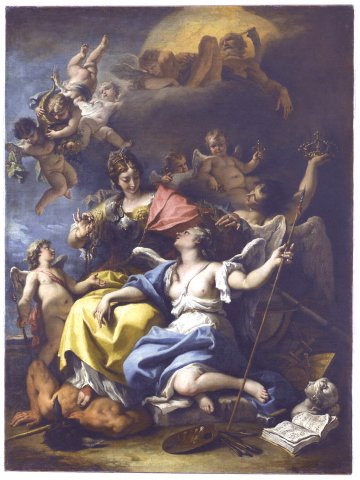
The baroque list of possible personifications is intended to highlight the heterogeneous nature of a store of disparate pieces, contrary to the classical ideal of simplicity and propriety. If France is " a woman's figure " a woman's figure is not enough to identify France. Du Bos's caricature, however, points to a real difficulty in personification by depicting France as Minerva in his reception piece for the Académie in 1718, Sebastiano Ricci hardly singularizes her as France any better (ill. 1). So he adds an Apollonian sun on Minerva's chest, a reference to Louis XIV: by specifying its referent, the allegorical personification becomes more complicated and, by the same token, more opaque. Elsewhere it will be a different code: in La France implorant la protection de sainte Geneviève (1726, ill. 2), Jean François de Troy designates France with an ermine coat and a fleurdelisé globe.
Designating the Tiber as " a figure of a reclining man " proceeds from the same simplifying casualness. In his Iconologie (1603), Cesare Ripa gave a far more precise description : " che sta giacendo, & sotto il braccio destro tiene une lupa, sotto la quale si veggono due piccioli fanciullini5 " ; the Alegory of the Tiber by Le Brun and Dughet respects grosso modo the program, with its reclining old man holding a jar from which the river's water flows, and resting his left leg on the she-wolf at whose flank Romulus and Remus are asleep (ill. 3). The jar generically indicates the river; the she-wolf and twins specifically distinguish the Tiber. This allegorical characterization of the character then barely differentiates allegory from a historical subject, such as the Romulus and Remus painted by Rubens in 1613, where the scene of the discovery of the twins by the shepherd Faustulus is witnessed by the river god, who both characterizes the scene's location and is characterized by it (ill. 4)6. In contrast, the simple " figure of a reclining man " gives itself to be seen without reading, without allegorical deciphering : it is a piece in a composition, the element of a scene, a visual detail and no longer a hieroglyphic syntagm.
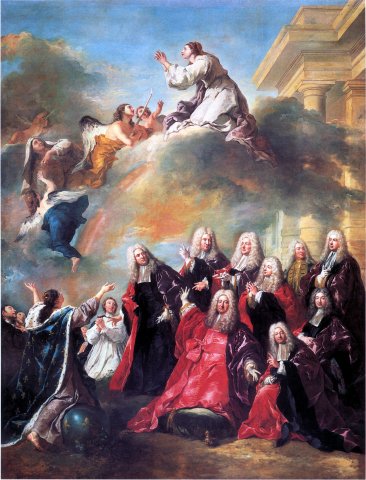
As for the slander under a satyr figure, it's completely out of the traditional emblematic coding. It's apparently a reference to Rubens. François Noël's Dictionnaire de la fable (1801), in the article Calomnie, states that " Rubens painted calumny in the Luxembourg gallery in the form of a satyr sticking out his tongue ". The Luxembourg gallery then contained the Cycle of Marie de Médicis, now in the Louvre. None of the twenty-four canvases that make it up is specifically dedicated to such a personification of Calumny : Rubens did not paint pure allegories at the Luxembourg, but what Du Bos calls mixed compositions, where allegorical personifications accompany, frame the story. In the painting of La Félicité de la Régence, beneath the throne of Marie de Médicis holding the scales of Justice in one hand, the scepter and globe of Power in the other, we can make out in the lower right the crushed figures of the evils the Regent has repelled. Completely to the right, a satyr opens his misshapen mouth and sticks out his tongue. It was probably Félibien's commentary on this that led to Du Bos's formula, which subsequently found its way into dictionaries:
" On one side is a young child who laughs, & who holds attached Ignorance, Meditation & Envy, which the Painter has represented ; the first, with donkey ears ; the second, under the figure of a Satyr who sticks out his tongue ; & the third, under the figure of a very skinny woman, overturned on the ground. " (Félibien, VII. Entretien sur les Vies et les Ouvrages des Peintres, in Entretiens, t. III, Trévoux, 1725, p. 4227.)
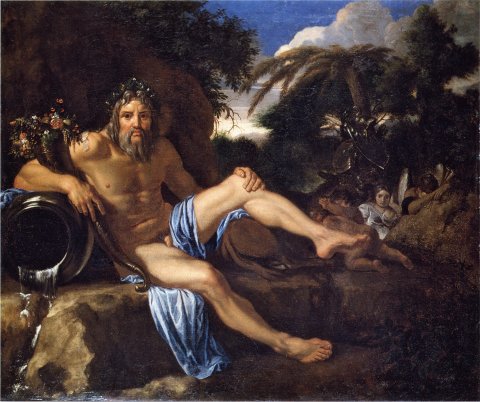
This vaguely tongue-tied satyr is certainly not a canonical allegory. Du Bos probably drew on it to caricature and denigrate a practice of pictorial writing that he disapproved of as obscure and incomprehensible. In the same painting, in fact, it is first and foremost the personification of Marie de Médicis in the known and received form of Authority as described by Cesare Ripa in his Iconology8 that strikes the eye and determines the overall reading of the composition. And while we're on the subject of sticking out our tongues, we might as well mention, in the painting of La Paix d'Angers, the woman on the right, from whose mouth a snake emerges : this is the personification of Envy, as painted by Giotto, for example, in the Capella dei Scrovegni in Padua9.
And that's where the problem lies: from the moment when the painter codifies his allegorical personifications on the fly, when he multiplies them in the profusion of a discourse of which he alone has the key, the allegory becomes incomprehensible this is the essential reproach levelled at him by Du Bos, contrasting Raphael with Rubens:
" Modern allegorical figures are those that painters have invented recently and are still inventing to express their ideas. They characterize them in their own fashion, and give them the attributes they believe best to make them recognizable.
[...] The painters who pass today for having been the greatest poets in painting are not those who gave birth to the greatest number of allegorical characters. It is true that Raphael produced some of this kind, but this wise painter only used them in the ornaments that serve as borders or supports for his paintings in the Signature apartment. He even took the precaution of writing the names of these allegorical characters under their figures. " (P. 63.)
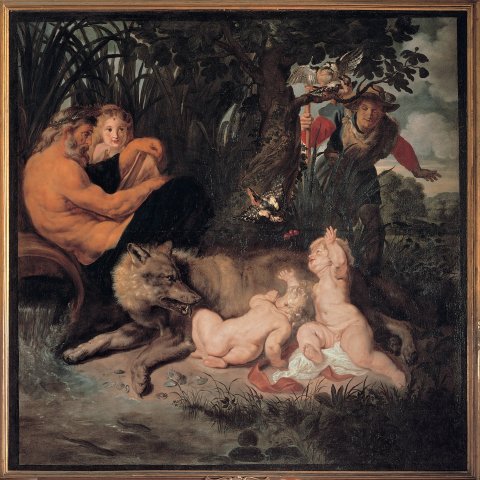
Allegory functions as a language. But unlike medieval allegory, it no longer masters or imposes its code10. It unfolds, scattered in fragments of visual writing whose key is not given. The image must itself deliver its code, and pictorial invention never ceases to make up, through its emblematic ramifications, for the original failure of the signified, the loss of meaning that threatens the composition as a whole.
Raphaël, in the Signatura Room in the Vatican (ill. 6), is said by Du Bos to have found an ingenious way of clarifying his allegorical personifications: pushing them to the margins of the composition, outside the story, to the place devolved to the grotesques, he would have endowed them with explanatory writings. We're looking in vain for these signs on the spot. There are indeed figures in grisaille that " serve as support " to the great allegorical compositions that are L'École d'Athènes and La Dispute du Saint Sacrement, but these figures are not explained by any inscription. On the other hand, allegorical personifications are not confined to border and ornamental positions : in the lunette above the window, for example, the three cardinal virtues that accompany Justice, namely Fortitude, Prudence and Temperance, are arranged together to make a scene. As for the inscriptions found in the compositions, they certainly provide clues to understanding the allegories, but these clues are also enigmas. Thus, for the ceiling medallions, jus suum cuique tribuit11, " elle attribue à chacun son droit ", designates Justice, while Numine afflatur12, " she is inspired by divine will ", characterizes Poetry.
II. Allegorical dissemination
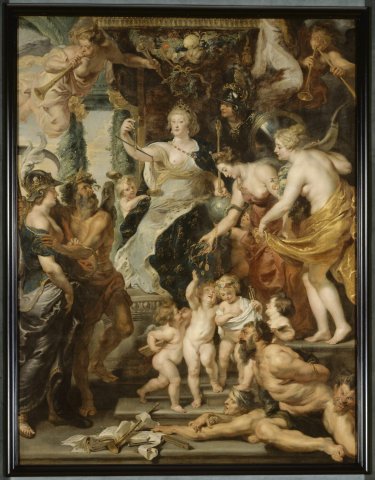
The opposition established by Du Bos between an unreasonable and a reasoned use of allegorical personification, which overlaps with the stylistic opposition sometimes made in art history between Baroque and Classical art, appears here clearly as a surface discourse, as the ideological polarization of a global and massive phenomenon of allegorical dissemination, linked to a consciously and methodically perverted use of the image as emblematic, or, if you prefer, hieroglyphic writing13. Basically, there's no difference between pure allegory and mixed composition, between respect for a certain verisimilitude and shameless recourse to the marvelous. All the differentiations Du Bos begins by establishing fall away as soon as we get into the details of the examples : in the examples he gives, allegory is in fact always mixed14 and mixes historical characters and fabulous personifications ; as for respect for verisimilitude, which makes him criticize the harbor tritons in the Arrival of Marie de Médicis in Marseille (ill. 8), he is gradually lukewarm until he falls completely. Du Bos begins by conceding the co-presence of the two worlds, the historical and the allegorical, insofar as the personifications can be believed to be true by the characters who rub shoulders with them.
" My criticism is not based on the fact that there never were mermaids and nereids, but on the fact that there were none left, so to speak, in the times when the event that gives rise to this discussion [i. e.the arrival of Marie de Médicis in Marseille, on November 3, 1600, at least ten centuries after the disappearance of paganism]. I would agree that there are historical compositions where mermaids and tritons, like other fabulous divinities, can take part in an action. These are the compositions that represent events that happened during paganism and when the world believed that these divinities really existed. " (p. 65.)
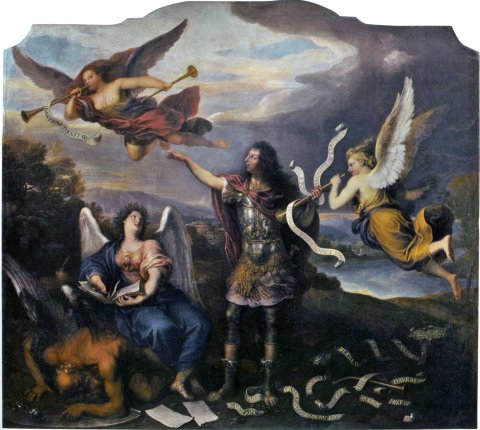
We note that the subject has shifted from genuinely allegorical figures such as France, the Tiber, Calumny, or, in Raphael, Justice and the Virtues, to decorative figures whose allegorical significance is fading. From the problem of meaning and comprehension, we have moved on to that of composition and coherence. But even when faced with the moderate solution of coherence without meaning, Du Bos backs away, recognizing, against the economy of verisimilitude, if not the relevance, at least the existence of an economy of the marvelous. He begins by severely condemning this economy, quoting Lactantius: " Learn that poetic license has its bounds, beyond which it is not permitted to carry fiction15. " But in section 28, " Of verisimilitude in poetry ", he relies on Vida to argue pretty much the opposite:
" Many invented traits can be added to authentic facts, says Vida16. Poets and painters who do so are not called liars. Fiction passes for falsehood only in works that are given to contain exactly the truth of facts.
[...] After this, let those bolder than I dare to mark the boundaries between verisimilitude and the marvelous." " (I, 28, 80-81.)
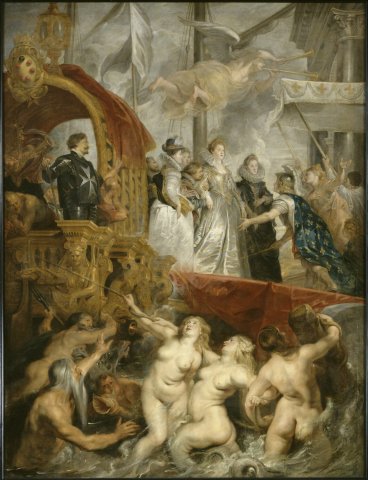
This retroactively justifies allegory, its mixed compositions and personifications. The contradiction in which Du Bos finds himself, and which he assumes throughout section 28, is that of the century, which condemns allegorical personification as contrary to classical standards of composition and verisimilitude, and at the same time practices it outrageously, particularly in opera, because it recognizes it as having unrivalled fictional, imaginative effectiveness.
The nature of this effectiveness is rather surprising. While Du Bos criticizes allegory for its propensity to dissemination, the excessive profusion of characters, the complexity of signs and codes, the dispersion of the spectator's attention, solicited on all sides to solve insoluble enigmas, the efficacy he recognizes in allegory is an efficacy of condensation17 :
" Painters derive great help from these allegorical compositions of the second kind [i. e. mixed compositions], either to express many things which they could not convey in a historical composition, or to represent in a single picture several actions each of which seemed to require a separate canvas. The Luxembourg and Versailles galleries bear witness to this18. Rubens and Le Brun have found a way to use these mixed fictions to represent things that we never imagined could be rendered in color. They show in a single painting events that a historian could only narrate in several pages" (I, 24, 67.)
There's something here that turns on its head, that engages the general history of representation. The mainspring of allegorical dissemination is the identification it presupposes between representation and writing : even when it expresses itself in painting, when it plays, as in Rubens, on the most shimmering effects of image and color, allegorical personification consists in fragmenting meaning into pieces of writing. When Du Bos praised Raphael for the " explanation of symbols " that he is said to have written beneath his allegorical figures in the Chambre de la Signature, an explanation that is not actually there, he was referring in his own way to the scriptural efficacy of these figures, drawing in the space of the chamber a constellation of words, or written enigmas. As for the Prince de Conti's sublime idea (ill. 7), it basically consisted in disseminating inscriptions in the space of representation :
" So he had the Muse de l'histoire drawn, an allegorical but well-known character holding a book on whose spine was written Vie du prince de Condé. This Muse tore off leaves from the book, which she threw on the ground, and we read on these leaves Secours de Cambrai, Secours de Valenciennes, Retraite de devant Arras ; finally the title of all the fine deeds of the Prince de Condé during his stay in the Spanish Netherlands, deeds of which everything was commendable, with the exception of the scarf he wore when he did them. " (P. 67.)
The scattering of pages of history, which cannot be directly illustrated because Condé was then fighting against the King of France, but which must not be forgotten because the man conducted himself heroically there, identifies the allegory with a constellation of words whose personification of History organises the dynamic movement of dissemination, while at the same time structurally tightening the organic unity. Allegory precedes the visual advent of images. It produces them, manipulates them from a world of codes, signs, hieroglyphics, where the logic proper to images has no course.
Here we touch on the two sides of the allegorical spirit. On the one hand, it's the beautiful spirit, who speaks to say nothing and fabricates endless hollow allegories :
" Besides, it's impossible for a play, whose subject is allegorical action, to interest us much. Those that writers, to whom no one denies wit, have ventured in this genre, have not been as successful as those in which they had been willing to be less ingenious and treat a subject historically. The brilliance that springs from a metaphorical action, the delicate thoughts it suggests and the fine turns with which its allegory is applied to the follies of men, in a word all the graces that a fine mind can draw from such fiction are out of place on the theater. " (I, 25, 73.)
But this ingenious spirit, this brilliance that is disseminated in " delicate thoughts " and in " fine tricks "It's also the spirit of the witty line, which condenses meaning and brings together all the narrative sinuosity of events in a single tableau, the unfolding of an entire story in the suspense of a single moment19. The incomprehensibly piled-up enigmas of the allegorical storehouse then turn into the shattering, synthetic illumination of the allegorical sublime idea, which gathers and unifies the scriptural fragments in the surprise of a single glance.
III. Putting an end to the expression of passions
There is here an organizing principle of representation fundamentally heterogeneous to academic ideology, as constituted around the Conférences de l'Académie and in particular Le Brun's decisive lecture on the expression of passions20. Du Bos first contrasts " the invention of allegorical mysteries " with " the expression of passions " :
" ...the enthusiasm that makes painters and poets does not consist in the invention of allegorical mysteries, but in the talent to enrich one's compositions with all the ornaments that the verisimilitude of the subject can allow as well as to give life to all these characters through the expression of the passions. " (p. 71.)
The expression of passions is a poetics of the figure : the stake of representation is the differentiation of figures in relation to a given subject. To differentiate them, the artist varies their expression according to their relationship to the action or event represented. This variety of expression is a matter of ornament, of enriching the subject, according to a rhetorical logic of variation.
In contrast, allegorical invention is the poetics of the emblem21 : characters are characterized not by the defining, internal trait of their expression, but by their external meaning, i.e. by the accessories that allow us, at their periphery, to decipher them by what they hold, wear, crush or embrace. We can always add a new accessory, a new character, to illuminate and guide the deciphering process. The logic, then, is not one of variation, but of invention.
The fact that invention is on the side of allegory argues for it and hinders Du Bos's argument, which then attempts to place imagination on the side of expressing passions, against a paradoxical sterility, or ease of allegorical invention:
" One must have a more fertile and accurate imagination to imagine and encounter the features that nature uses in the expression of passions, than to invent emblematic figures. These symbols can be produced with the help of two or three books, which are inexhaustible sources of such knick-knacks, but it takes a fertile imagination, guided by a wise and judicious intelligence, to succeed in the expression of passions and to paint their symptoms with truth" (Ibid.)
The aim is to reduce the status of allegorical personification : " emblematic figures " become " symbols " (with the depreciative demonstrative), then " similar colifichets ". The allegorical emblem is located outside the figure: symbols, and even more so trinkets, refer less to the figure itself than to its accessories, from which it derives its meaning. In contrast, the logic of expressing the passions focuses the imagination's efforts on the interior of the figure, not the figure itself, but the "symptoms" of the passion within it. Symptoms are opposed to colifichets, like interiority to exteriority, like sentiment to writing.
Or the problem of feeling is its irreducibility to representation. The allegorical mysteries mocked by Du Bos are succeeded by the mysteries of the intimacy of passion :
" All expressions must take their cue from the head character we give to the character we represent agitated by a certain passion. It is therefore necessary for the worker's imagination to make up for all that is most difficult for him to do in expression, unless he has in his workshop a model even greater actor than Baron22. " (p. 72.)
It's on the inside that the character is " agitated by a certain passion ", but it's on the outside that we have to represent this intimate agitation, through " symptoms ". But the painter rarely sees these symptoms on the model in front of him in his studio so he has to imagine them. At a time when the poetics of the figure shifts the representational arts from allegorical writing to the visibility of symptoms, the category of the visual emerges negatively, as an observation that it's impossible to see.
.
" One must, so to speak, know how to copy nature without seeing it. You have to be able to imagine [...] what its movements are in circumstances where you never experience it. [...] You can see part of nature in your model, but you can't see what's most important in relation to the subject you're painting. We see the subject that passion must animate, but we do not see it in the state in which passion must reduce it, and it is in this state that it must be painted. " (p. 71-72.)
We see and we don't see it's what we don't see that we have to make visible. The negative emergence of visibility sets up the beat of the scopic impulse, while what emerges as the new paradigm of representation against the old allegorical emblem is not the figure expressing the passions, but the model, with the new ambiguity it introduces : the model is the living model that the painter pays and installs in his studio, and is at the same time the abstract model, " the state " ideal that the artist imagines as " what is most important in relation to the subject being painted ".
This ideal model, Diderot will theorize in the Paradoxe sur le comédien, using, among others, the example of the comedian Baron advanced here by Du Bos, reattaching his garter in Le Comte d'Essex23. The ideal model cannot emerge as a founding, post-figurative category of modern representation than from this reversal of allegorical personification that prepares the beating of seeing and the experience of self-possession:
" The Second. - However there will be truths of nature.
The First. - As there are in the statue of the sculptor who has faithfully rendered a bad model. One admires these truths, but finds the whole poor and contemptible. I'll say more: one sure way to play small and petty is to have to play your own character. You're a tartuffe, a miser, a misanthrope, you'll play a misanthrope, a miser, a tartuffe, and you'll play it well; but you'll do nothing of what the poet did, for he did, himself, the Tartuffe, the Avare and the Misanthrope.
The Second. - What difference do you think there is between a Tartuffe and the Tartuffe ?
The First. - Clerk Billard is a tartuffe, Abbé Grizel is a tartuffe, but he's not the Tartuffe. The financier Toinard was a miser, but he was not the Miser. L'Avare and le Tartuffe were made after all the Toinards and all the Grizels in the world; these are their most general and most marked traits, and this is the exact portrait of none, so no one recognizes himself in it. " (Paradoxe sur le comédien, p. 125.)
First we had to see, beyond the common expression of the studio model, the ideal expression of a passion that this model would have been quite incapable of playing. Now we have to get rid of ourselves to create the ideal model we want to play. This ideal model, "all the Toinards and Grizels in the world", is a personification, but an anti-allegorical personification. Allegory abstracts, while the model concretizes. Allegory allows us to decipher an idea from concrete props; the model allows us to see "all the Toinards and Grizels in the world" from the Platonic idea according to which it was conceived. Between allegory and model, the figure, with its classical ideal of expressing passions, appears as a fragile and precarious transition caught up in the rhetorical game of expressive variations, the figure is still a discursive mechanic ; but pointing, instead of the signs of allegory, to the symptoms of interiority, it already spawns the pulsations of visuality whose ghostly game of possession and dispossession the model will fully assume.
.
If the figure competes with allegorical personification, the model, on the contrary, marks its return, its inverted reconstitution. This filiation was spotted by Walter Benjamin in the Origine du drame baroque allemand, whose developments on the system of Baroque allegory in the trauerspiel strikingly illuminate the words of Abbé Du Bos24. Benjamin shows how this allegory becomes incomprehensible to the German Romantics as well as to literary critics emerging from Romanticism, because a thought and practice of symbol developed in place of allegorical presentation (p. 177) :
" And even today, it is nothing less than obvious that in the preponderance of the thing over the person, of the fragment over the whole, allegory and symbol represent opposite poles, and thereby of equal importance. Allegorical personification has always entertained the misleading idea that its function was not to personify things, but on the contrary to represent only the thing in a more imposing way by cloaking it in all the attributes of the person. " (P. 201.)
What Benjamin, following in the footsteps of German Romanticism, calls symbol, is model. On either side of the figure takes place a pivot through which allegorical personification, with its ancient and medieval roots, communicates directly with modernity. Materialization and fragmentation lead us to think in terms of device, where the architecture of places, but also the simultaneity of narrative times, play an essential role. Allegory prepares the stage as the nodal device of representation; the model implements it. In the eighteenth century, the notion of the moment, the instant of the scene, was introduced by Shaftesbury's essay on the Judgment of Hercules, on which Diderot's article Composition for the Encyclopédie builds. Yet what is the Jugement d'Hercule, if not the installation of a model, Hercules, not the Hercules of fable, but Hercules in the sense of every man, of " tous les Toinards et tous les Grizels du monde " between two allegorical personifications ?
Notes
See Nathalie Rizzoni, " Quand l'Absence apparaît... L'allégorie au théâtre au dix-huitième siècle ", Studies on Voltaire and the eighteenth century, 2003, n° 7, p. 429. In this decisive and pioneering article, Nathalie Rizzoni explains this paradox by the complex status of the fairground stage, where these allegorical shows were performed : heritage of a medieval practice, mixed audience (p. 443). But we find the same explosion and depreciation of allegory in painting, for productions intended for quite different venues... The use of the fairground stage exploits the paradox, but does not explain it.
S. Lojkine, " De la figure à l'image : l'allégorie dans les Salons de Diderot ", op. cit., p. 343sq.
B. Tane, " From Fury to Perversion? Avatars de l'alégorie dans les frontispices du Paysan perverti de Rétif de la Bretonne ", op. cit., p. 395sq.
Étienne Wolff's edition reproduces the text of the posthumous 1755 edition published by Pissot.
... who stands reclining and, under his right arm, holds a she-wolf under which are two small toddlers.
Rubens is said to have been inspired by a Roman sculpture in the Vatican's Belvedere collection of antique sculptures (see cat. of the Rubens de Lille exhibition, 2004, notice 131, p. 240). Ripa explicitly takes this sculpture, now in the Louvre (Ma593), as his model in his article Tevere.
The first publication of the five volumes of Félibien's Entretiens ran from 1666 to 1688.
" Autorità, o Potestà. Una Matrona, che sedendo sopr'una nobil sedia, sia vestita d'habito ricco & sontuoso fregiato tutto di varie gioie di grande stima, con la destra mano alzata tenghi due chiave elevate [these two keys are replaced in Rubens by the pans of the scales of Justice] ; con la sinistra un scettro & da una banda vi sieno libri, & dall'altra diverse armi. " (A Matron who, seated on a throne, is dressed in a rich and sumptuous garment all adorned with various jewels of great price that with her raised right hand she holds out two brandished keys, with her left hand a scepter that on one side she has books, on the other various weapons.)
Alongside La Félicité de la Régence, Rubens painted a Allégorie du bon gouvernement, currently housed in the Musée du Château de Blois. Most of these allegorical codes (throne, scales) date back to the Middle Ages: see, for example, the Good Government fresco painted by Ambrogio Lorenzetti for Siena's Palazzo Pubblico in 1338-1339. See also Vana Nicolaïdou-Kyrianidou, " Le corps humain monstrueux comme allégorie du mauvais gouvernement : la politique et la barbe dans l'Acoluthie de Spanos byzantine ", L'Allégorie de l'antiquité à la Renaissance, dir. B. Pérez-Jean and P. Eichel-Lojkine, Champion, 2004, p. 437sq., especially p. 452-4 (structure and meaning of the " Christian body " as an allegory of good government).
In Ripa, however, Envy is content to be bitten by a snake: " haverà la mammella sinistra nuda, morsicata da una serpente, laqual sia ravvolta in molti giri sopra della detta mammella " (she'll have her left breast naked, bitten by a snake that will coil in many rings on said breast).
In fact, the rhetorical fixation of the allegorical code is late, and hardly takes place before the Renaissance : it corresponds to a theological disengagement from allegory. See Henri Weber, " Le temple allégorique, de Froissart à la Pléiade ", L'Allégorie de l'antiquité à la Renaissance, op. cit., p. 473sq.
The formula comes from Cicero's De natura deorum (justitia suum cuique distribuit, III, 38) and De finibus, V, 67. We find it again in Seneca (Letter 81, 7), Aulu-Gelle (XIII, 24), then Justinian's Institutes (1, 1, 3).
Maybe a Platonic reference (Phaedrus, 243-5).
" Painters still make use of these compositions for much the same purpose as the Egyptians employed their hieroglyphic figures, that is, to put appreciably before our eyes some general truth of morality. " (P. 66.) On the allegorical reading of hieroglyphs after the loss of their linguistic intelligibility, see Emmanuelle Valette, " Discours romains sur les hiéroglyphes : comment écrire avec des images ? ", Résistances de l'image, TIGRE, Presses de l'Ecole normale supérieure, 1992, and Claude Françoise Brunon, " Allégories hiéroglyphiques à la cour des Médicis ", L'Allégorie de l'Antiquité à la Renaissance, op. cit., p. 587sq.
The only example of pure allegory is that imagined by the Prince de Condé for the Cycle celebrating his father, where the Muse of History tears out the pages of the Prince's Life on which we can read the names of the battles he heroically won in Flanders despite not being of the King's party: " Unfortunately, this painting was not executed according to such an ingenious and simple idea. The prince [...] allowed the painter to alter the elegance and simplicity of his thought with figures that made the painting more composed..." (p.67). The painter is Michel II Corneille, and his painting, Le Repentir du Grand Condé, is preserved at Chantilly (ill. 7) : to the Muse of History, Michel Corneille has added two flying Renommées, the good one on his right trumpeting his repentance, the bad one on his left, from whom he silences the sound of his victories. Finally, History sits on Saturn, allegory of Time, which it tames and subdues.
Here's exactly what Lactantius says: " The poets did not invent the events themselves (if they did that, they would be completely stupid), but they added certain adornment (quemdam colorem) to the events ; for they did not say this to criticize, but to embellish. This is mainly because, believing that everything is the invention of poets, they adore what they don't know. They are unaware of the extent of poetic license, and how far invention can go yet the poet's trade consists precisely in elegantly transposing events that really happened, using ambiguous figures. To invent entirely what one reports is the characteristic of the fool and the liar, not of the poet " (Divinarum Institutionum libri 7, I, 11, pp. 39-40).
Marco Girolamo Vida (1485-1566), De arte poetica lib. III, Rome, L. Vicentinum, 1527, in-4°.
On allegory as condensation in Du Bos, see S. Lojkine, " De la figure à l'image : l'allégorie dans les Salons de Diderot ", Studies on Voltaire and the eighteenth century, 2003, n°7, Voltaire foundation, Oxford, p. 343-370.
Du Bos alludes, for the Galerie du Luxembourg, to the Cycle de Marie de Médicis painted by Rubens, for the Galerie des Glaces at Versailles, to the Histoire du règne de Louis XIV, painted by Le Brun. On the latter, recently restored, see Nicolas Milovanovic and Alexandre Maral (dir.), La Galerie des glaces : Charles Le Brun maître d'œuvre, RMN, 2007.
The German Romantic theorization of allegory will insist on this function of condensation, which it will identify with the pregnant moment : " Its stimulating, and sometimes overwhelming, character is linked to another property, brevity. It's like the sudden appearance of a spectre, or like a flash of lightning suddenly illuminating the darkness of night. It is a moment that addresses our whole being [...] [a moment that] conceals a future fraught with consequences or keeps the soul in a state of tension " (Friedrich Creuzer, Symbolik und Mythologie der alten Völker, besonders der Griechen, Leipzig, Darmstadt, 1819, pp. 59sq, quoted by Walter Benjamin, Ursprung des deutschen Trauerspiels, 1916-1925, 1974 ; Origine du drame baroque allemand, French trans. Sibylle Müller, Flammarion, 1985, Champs, 2000, p. 176).
Charles Le Brun, " Sur l'Expression des passions ", April 7 and May 5, 1668, in Les Conférences de l'Académie royale de peinture et de sculpture au XVIIe siècle, ed. A. Mérot, ensb-a, 1996, pp. 145-162.
See Anne-Élisabeth Spica, " Emblematique et allégorie (XVIe-XVIIe siècles) ", L'Allégorie de l'Antiquité à la Renaissance, op. cit., p. 613sq.
Michel Baron (1653-1729), a pupil and protégé of Molière, also played the great roles of Corneille and Racine.
Paradoxe sur le comédien, A. Colin, p. 162.
Walter Benjamin, op. cit., p. 188-9. This movement to symbolize allegory is to be compared with the rhetoricization of medieval allegorical structures in the Renaissance analyzed by Henri Weber. See supra note 10.
Référence de l'article
Stéphane Lojkine, « Le modèle contre l’allégorie : la personnification au dix-huitième siècle », La Personnification du Moyen Âge au XVIIIe siècle, dir. Mireille Demaules, Classiques Garnier, coll. Rencontres, 91, 2014, p. 359-373.
Diderot
Archive mise à jour depuis 2006
Diderot
Les Salons
L'institution des Salons
Peindre la scène : Diderot au Salon (année 2022)
Les Salons de Diderot, de l’ekphrasis au journal
Décrire l’image : Genèse de la critique d’art dans les Salons de Diderot
Le problème de la description dans les Salons de Diderot
La Russie de Leprince vue par Diderot
La jambe d’Hersé
De la figure à l’image
Les Essais sur la peinture
Atteinte et révolte : l'Antre de Platon
Les Salons de Diderot, ou la rhétorique détournée
Le technique contre l’idéal
Le prédicateur et le cadavre
Le commerce de la peinture dans les Salons de Diderot
Le modèle contre l'allégorie
Diderot, le goût de l’art
Peindre en philosophe
« Dans le moment qui précède l'explosion… »
Le goût de Diderot : une expérience du seuil
L'Œil révolté - La relation esthétique
S'agit-il d'une scène ? La Chaste Suzanne de Vanloo
Quand Diderot fait l'histoire d'une scène de genre
Diderot philosophe
Diderot, les premières années
Diderot, une pensée par l’image
Beauté aveugle et monstruosité sensible
La Lettre sur les sourds aux origines de la pensée
L’Encyclopédie, édition et subversion
Le décentrement matérialiste du champ des connaissances dans l’Encyclopédie
Le matérialisme biologique du Rêve de D'Alembert
Matérialisme et modélisation scientifique dans Le Rêve de D’Alembert
Incompréhensible et brutalité dans Le Rêve de D’Alembert
Discours du maître, image du bouffon, dispositif du dialogue
Du détachement à la révolte
Imagination chimique et poétique de l’après-texte
« Et l'auteur anonyme n'est pas un lâche… »
Histoire, procédure, vicissitude
Le temps comme refus de la refiguration
Sauver l'événement : Diderot, Ricœur, Derrida
Théâtre, roman, contes
La scène au salon : Le Fils naturel
Dispositif du Paradoxe
Dépréciation de la décoration : De la Poésie dramatique (1758)
Le Fils naturel, de la tragédie de l’inceste à l’imaginaire du continu
Parole, jouissance, révolte
La scène absente
Suzanne refuse de prononcer ses vœux
Gessner avec Diderot : les trois similitudes

